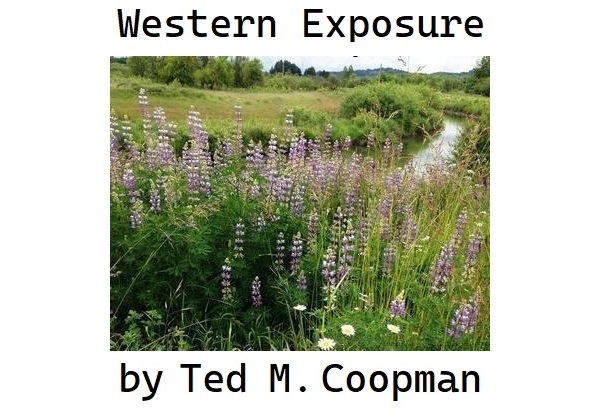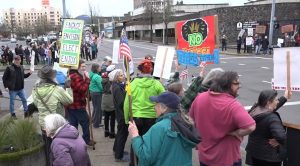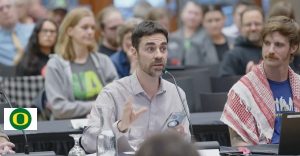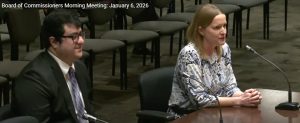Talk left, walk right
8 min read
by Ted M. Coopman
Many of us were baffled by the heated rhetoric and personal attacks around issues of housing and density. We were branded as anti-progressive heretics for asking inconvenient questions and pointing out serious flaws in proposed policy solutions.
Progressivism as a political philosophy argues we can improve human societies through political reform via advancements in science, technology, economic development, and social organization. Generically, once the political right ruined the previously well-understood “liberal” identity through relentless attacks, many on the political left took to identifying themselves as “progressives.” Most folks who identify as progressives support issues such as abortion rights, equal rights of women, minorities, and GLBTQI+, more government support for those in need, and environmentalism, all loosely defined.
Unleash the kraken, er, the magic of the free market!
A widely shared intent of progressive politics is to blunt the worst aspects of capitalism and level the playing field between the rich and poor via good public policy. However, some self-described progressives voice expansive claims while they enrich themselves and allies.
One of the most egregious examples of this Orwellian doublespeak is in the en vogue push to eliminate single-family zoning. The loudest proponents insist that single-family zoning is inherently racist and the major cause of the affordable housing crisis. There is no credible evidence that radical deregulation of the zoning for single-family neighborhoods, absent serious requirements that new development provide substantial low-income housing, will improve housing affordability for low-income families, let alone foster racial equity.
Changes that are based on evidence and good-faith involvement of the homeowners and renters whose lives will be impacted can enable more efficient use of urban land as well as create walkable neighborhoods and reduce carbon emissions. However, simply reducing lot sizes and increasing allowable density with no requirements for sufficient infrastructure and no standards to mitigate serious negative impacts on neighbors only enrich outside investors, cause displacement, and weaken the fabric of neighborhood communities.
The central premise of density mandates like HB 2001 is that excessive regulation is the problem and to meet our housing needs we must massively deregulate housing and “unleash the magic of the free market.” Moreover, that by easing the constraints on construction of market rate housing, it will “create” more affordable housing.
This falsely-pitched-as-a-progressive solution is, in fact, vintage 1980s Reaganomics with an added dash of trickledown economics—more money for the rich eventually means more money for the poor. Reaganomics has been a major factor in rising inequity, and trickle-down economics has been widely discredited as a ploy to simply reduce taxes for the wealthy.
There was no inclusion of affordability or implementation of “land value capture” (also called “land value return,” see below) in HB 2001. Eugene’s “Middle Housing” code amendments included nothing more than an ineffectual affordable housing façade for the most extreme increases in allowable density. In reality, there is actually neither an enforcement mechanism nor any requirement that income-qualified rentals can’t be converted to market rate within a year or even a month.
There are also no metrics to gauge impacts on housing affordability and displacement. What the city has created is purely a great new opportunity for certain developers, investors, architects, and realtors to make a lot of money.
So, how is all this progressive? Let’s unpack HB 2001 in light of how the magical market actually functions and how private regulation protects privilege regardless of public policy.
First, an extensive number of subdivisions in Eugene are exempt from any HB 2001 requirements, as long as the subdivision had CC&Rs—Covenants, Conditions, and Restrictions—in place to restrict housing to one home per lot before HB 2001 was adopted. It does not matter that city zoning code allows for building ADUs or fourplexes on small lots. If you live in one of these subdivisions, no developer can buy your neighbor’s property and build a fourplex.
This means thousands of houses in Eugene—including neighborhoods where some of our elected officials who supported HB 2001 live—will always have their low-density suburban dream. Unsurprisingly, these neighborhoods tend to be wealthier and whiter than those who bear the brunt of density.
Second, land is more expensive in higher-income neighborhoods. Higher land values effectively eliminate the economic incentives (profit) of building denser housing since buying land and tearing down existing high-end homes is prohibitively expensive. Moreover, any multifamily homes built will cater to higher-income renters since building these units is much more expensive. Combined, this makes increased density in higher-income neighborhoods or that those homes will be affordable by any measure, unlikely.
Third, land and housing structures are less expensive in lower-income neighborhoods. Lower land values increase the economic incentives (profit) of building denser housing since buying land and tearing down existing homes is comparatively inexpensive. Combined, this makes increased density in lower-income neighborhoods much more likely.
But that doesn’t mean improving housing affordability because with a strong demand from upper-income households, the most profitable choice for investors is to build rentals for the upscale market. The simple math is one older, but affordable house subtracted from available housing and four (or more) new, expensive apartments or condos added to inventory.
Many homes in lower income neighborhoods are older, more affordable rentals prized by families with children who desire a yard. Not only are these families’ options reduced by demolitions, but the price of remaining homes also increases because developers bid more than any first-time home buyers can match. This displacement and conversion from home ownership to what the investors call the “permanent renter” deprives many low- and middle-income households of the opportunity to build generational wealth. That’s not “progressive” in any way, shape, or form.
Finally, land and housing are not commodities like beans and gasoline. Building additional, expensive rental housing does not reduce the cost of homes that a lower-income household might rent or purchase. The so-called “filter effect” argues (without evidence) that as you create more high-end housing, people will move “up market” creating more affordable housing since sellers/landlords won’t be able to charge as much.
The problem is: Housing is highly segmented, and location is a significant variable. Not only does the same house have a different value in different locations, a buyer’s desires for location and amenities impact how much they are willing to pay. More apartments with rents targeted at middle-income renters will, generally, mean higher vacancy rates and lower rents for similar apartments (ignoring location).
But the increase in that segment of the housing market won’t lower prices for more or less expensive rentals. What rent control in places like New York City demonstrated is that just because someone can move upmarket does not mean they will and often they will stay put to save money, especially if the location works for their lifestyle.
Over time, rent in a neighborhood tracks the highest rent charged, just as house prices are affected by the highest amount paid. In this way, new and more expensive rentals often raise, not lower, rents. This is a major cause of development gentrification.
I am not suggesting we do not need to build more housing and increase density in sensible and evidence-based manner, just that we need to be honest about how the housing market actually works. We also need to be honest that the current density mania is more about making money than making housing. Housing advocates think they are using developers, and the developers think they are using the advocates, and one of these groups is tragically mistaken.
The dirty little secret of upzoning
Policy changes in land use change the value of land. When land is zoned for single-family homes, the value of that land is determined by what can be built – a single-family home. However, if you change what can be built to allow a fourplex, or two fourplexes on larger lots, the value of that land increases significantly. The community’s upzoning enriches the property owner through no efforts of their own. But the serious unearned profit is realized by the investor who redevelops the property with multiple upscale rentals.
Smart communities around the United States and across the world are realizing that at least some of that “land value” produced by the community through upzoning should be captured and reinvested in affordable housing for lower-income households in the same community.
Both HB 2001 and the Eugene “Middle Housing” code amendments create enormous additional land value, but Eugene doesn’t get any portion of the value. This misguided, supposedly progressive public policy results in private profit while fueling displacement via development gentrification. Many nations and municipalities recognize this windfall and have implemented land value capture policies and programs to a fair portion of the value generated by public policy changes. Boston is a good example.
Again, if the primary interest was in benefiting those most impacted by housing shortages, we would not be facilitating massive profits for the few, while displacing the many from existing affordable housing. Even making the case that we need market rate housing; wouldn’t it make sense to blunt those impacts by extracting some of that profit for the common good?
Bottom-up vs. top-down
We need more housing to meet the needs of current, let alone, growing populations. An adequate range of housing costs needs to be attainable for everyone. If we were to increase inventory across all segments than prices would likely drop across the board, as well.
However, we know that households in the bottom 30% of the income are unlikely to be able to afford any market rate housing. Right now, with policies like HB 2001, we are focusing on creating inventory from the top down, since there is a massive incentive to build where developers and investors can make the most profit. Their goal is, understandably, to maximize profit. It isn’t realistic to expect them to develop affordable housing and make less profit.
However, it is reasonable and practical to use “land value capture” to leverage developers’ interests to benefit those not served by market rate housing. If we are going to use public policy to create more housing, we should focus on creating affordable housing now, that can be used immediately, not on a promise that expensive market rate housing built now just might create affordable housing sometime in the future.
We need to create more inventory but should focus on building from the bottom up, rather than from the top down. So given the two choices:
- Maximize investor profits now and maybe low-income housing later
- Offer investors adequate profits now and use the captured margin to build low-income housing at the same time
Which choice is more progressive?
Western Exposure is a semi-regular column that looks at issues and challenges from a West Eugene perspective – a perspective that is often ignored or trivialized by city leadership and influential groups and individuals largely based in south and east Eugene.
Western Exposure rejects the fauxgressive party line, performative politics, and “unicorn ranching” policy in favor of pragmatism focused on the daily experiences of residents and small businesses in Eugene—and West Eugene in particular.
Ted M. Coopman has been involved in neighborhood issues since 2016 as an elected board member, and now chair, of Jefferson Westside Neighbors and has 30+ years experience as an activist and community organizer. He earned a Ph.D. in Communication (University of Washington) and served on the faculty at San Jose State University from 2007 to 2020.
Ted’s research on social movements, activist use of technology, media law and policy, and online pedagogy has been published and presented internationally and he taught classes ranging from research methodology to global media systems. He and his spouse live in Jefferson Westside with an energetic coltriever and some very demanding and prolific fruit trees.






